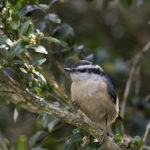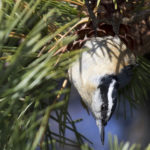Vol. 17 Issue 4, Winter 2012
by Mary Ann Good
 The Red-breasted Nuthatch is a bird of northern woods and western mountains. However, during occasional years, known as “irruption years,” these tiny sprites will favor us in the mid-Atlantic region with visits to our woods, backyards, and feeders. Their appealing behavior, attractive plumage, and confiding nature make their irregular fall and winter visits a reason for great cheer among birders and feeder watchers alike. This fall/winter is shaping up to be such an irruption year, as they have shown up in good numbers throughout our region. Since their venturing farther southward means that their normal food sources were not sufficient in their usual wintering range, be sure to put out the welcome mat for these tiny visitors, and hopefully they will return the favor with up-close views of their delightful ways!
The Red-breasted Nuthatch is a bird of northern woods and western mountains. However, during occasional years, known as “irruption years,” these tiny sprites will favor us in the mid-Atlantic region with visits to our woods, backyards, and feeders. Their appealing behavior, attractive plumage, and confiding nature make their irregular fall and winter visits a reason for great cheer among birders and feeder watchers alike. This fall/winter is shaping up to be such an irruption year, as they have shown up in good numbers throughout our region. Since their venturing farther southward means that their normal food sources were not sufficient in their usual wintering range, be sure to put out the welcome mat for these tiny visitors, and hopefully they will return the favor with up-close views of their delightful ways!

Photos by David Boltz
The Red-breasted Nuthatch is a much smaller cousin of the White-breasted Nuthatch, which is a year-round resident in Loudoun County. It can easily be distinguished by its bright rust-colored underparts, strong black stripe through the eye, white stripe above the eye, narrow black cap, and blue-gray back. With a relatively long bill and short tail, they search along trunks and branches for hidden insects in bark furrows. Like their cousins, they are just as comfortable upside-down as upright – their antics at my bottom-accessed suet feeder are always fun to watch. They often travel in mixed flocks with chickadees, titmice, kinglets, and woodpeckers, especially in coniferous stands. During irruptive winters, they often use deciduous habitats such as orchards, scrub, parks, and shade trees. They make their presence known with an excited “yank, yank” that is higher-pitched than the White-throated, often described as sounding like a toy tin horn.
Not surprisingly, since their favored food is insects, Red-breasted Nuthatches readily visit suet feeders as a substitute protein. They also eagerly consume sunflower seed, especially the smaller and richer black oil sunflower. Whether you enjoy birds this winter from the comfort of your living room or get out onto the frozen trails, chances are good that you’ll have one of these spritely visitors pop into view or earshot.

